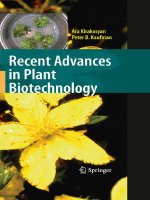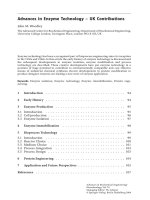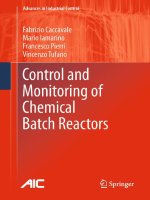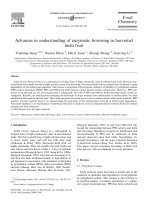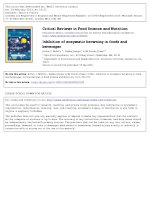Advances in understanding of enzymatic browning in harvested
Bạn đang xem bản rút gọn của tài liệu. Xem và tải ngay bản đầy đủ của tài liệu tại đây (162.11 KB, 4 trang )
Advances in understanding of enzymatic browning in harvested
litchi fruit
Yueming Jiang
a,b,
*
, Xuewu Duan
a
, Daryl Joyce
c
, Zhaoqi Zhang
d
, Jianrong Li
b
a
Department of Plant Resources, South China Institute of Botany, The Chinese Academy of Sciences, LeYiJu 510650, Guangzhou, PR China
b
College of Food Science, Biotechnology and Environmental Engineering, Hangzhou University of Commerce, Hangzhou 310035, PR China
c
Department of Agronomy and Horticulture, The University of Queensland, Gatton, Qld. 4343, Australia
d
College of Horticulture, South China Agricultural University, Wushan 510642, Guangzhou, PR China
Abstract
Litchi (Litchi chinensis Sonn.) is a subtropical to tropical fruit of high commercial value in international trade. However, har-
vested litchi fruit rapidly lose their bright red skin colour. Peel browning of harvested litchi fruit has largely been attributed to rapid
degradation of red anthocyanin pigments. This process is associated with enzymatic oxidation of phenolics by polyphenol oxidase
(PPO) and/or peroxidase (POD). PPO and POD from litchi pericarp cannot directly oxidize anthocyanins. Moreover, PPO sub-
strates in the pericarp are not well characterised. Consequently, the roles of PPO and POD in litchi browning require further in-
vestigation. Recently, an anthocyanase catalysing the hydrolysis of sugar moieties from anthocyanin to anthocyanidin has been
identified in litchi peel for the first time. Thus, litchi enzymatic browning may involve an anthocyanase–anthocyanin–phenolic–PPO
reaction. Current research focus is on characterising the properties of the anthocyanase involved in anthocyanin degradation.
Associated emphasis is on maintenance of membrane functions in relation to loss of compartmentation between litchi peel oxidase
enzymes and their substrates.
Ó 2004 Elsevier Ltd. All rights reserved.
Keywords: Anthocyanase; Anthocyanin; Browning; Litchi; Litchi chinensis; Lychee; Oxidase; Peroxidase; Phenolic; Polyphenol oxidase
1. Introduction
Litchi (Litchi chinensis Sonn.) is a subtropical to
tropical fruit of high commercial value in international
trade. The fruit typically has a bright red peel colour and
is sweet, acidic, juicy and soft but with crisp pulp
(Nakasone & Paull, 1998). Harvested litchi fruit are
highly perishable. They can rapidly lose their bright red
skin colour and turn brown within 1–2 days at ambient
temperatures (Huang & Scott, 1985; Jiang & Fu, 1998a;
Zhang & Quantick, 1997). Post-harvest browning of li-
tchi fruit has been attributed mainly to degradation of
red pigments in association with oxidation of phenolics
by polyphenol oxidase (PPO) and/or peroxidase (POD)
enzymes (Huang, Hart, Lee, & Wicker, 1990; Zauber-
man, Ronen, Akerman , Weksler, Rot, & Fuchs, 1991;
Zhang & Quan tick, 1997). Li and Yan (1963) first dis-
cerned the relationship between PPO activity and litchi
peel browning. Significant progress in purification and
characterisation of PPO and its substrates in litchi
pericarp tissue has since been made. Nonetheless, en-
zymatic browning is still the major practical limitation
to litchi fruit storage (Jiang, Yao, Lichter, & Li, 2003).
This paper reviews enzymatic browning of litchi fruit
after harvest, with an emphasis on recent advances.
2. Enzymes
2.1. Polyphenol oxidase
Litchi pericarp tissue browning is mainly due to the
oxidation of phenolics and degradation of red pigments
by polyphenol oxidase. This oxidase is also referred to
as catechol oxidase, tyros inase, catecholase or o-diphe-
nol oxygen oxidoreductase. PPO has been isolated and
*
Corresponding author. Tel.: +86-20-3725-2525; fax: +86-20-3725-
2831.
E-mail address: (Y. Jiang).
0308-8146/$ - see front matter Ó 2004 Elsevier Ltd. All rights reserved.
doi:10.1016/j.foodchem.2004.02.004
Food Chemistry 88 (2004) 443–446
www.elsevier.com/locate/foodchem
Food
Chemistry
purified from litchi fruit peel. Its pH and temperature
optima are 6.5 and 70 °C, respectively (Jiang, Zauber-
man, & Fuchs, 1997b; Jiang, Zauberman, Fuchs, & Fu,
1999). The enzyme can be inhibited by antioxidants,
such as glutathione an d
LL
-cysteine, and activated by
divalent cations, such as Mn
2þ
and Ca
2þ
(Jiang & Fu,
1998b; Jiang, Zauberman, Fuchs, & Fu, 1998). How-
ever, PPO activity during litchi fruit storage is evidently
inconsistent. Lin et al. (1988a) demonstrated a rapid
increase in PPO activity during the first 48 h of storage.
However, Zauberman et al. (1991) found no significant
change in the PPO activity during the same period. In
contrast, Underhill and Critchley (1994) reported a
progressive reduction in PPO activity. Apparently con-
tradictory findings for PPO activity may be due to dif-
ferences in methods and/or cultivars, and this merits
investigation.
2.2. Peroxidase
The relative significance of PPO acti vity is further ob-
scured by the presence of POD, a similar oxidative en-
zyme, in litchi pericarp. Lin et al. (1988b), Chen and Wang
(1989) and Underhill and Critchley (1995) have recorded
an increase in POD activity during litchi pericarp
browning. Gong and Tian (2002) have recently partially
purified POD from litchi fruit peel. They found that the
enzyme can rapidly oxidize 4-me thylcatechol in the
presence of H
2
O
2
and, thereby, form brown polyme ric
pigments. This finding further supports the case for in-
volvement of POD in enzymatic browning of litchi fruit.
The success of commercial sulphite treatment in
controlling litchi pericarp browning is an evidence for
the hypothesis that the browning is due to some types of
oxidative enzymes (Zau berman et al., 1991; Jiang et al.,
1997a). Involvement of both, PPO and POD, is consis-
tent with the author’s research results which showed
that inhibition of activities of the PPO and POD delayed
litchi pericarp browning. (Jiang & Fu, 1999c, 1999d;
Jiang & Li, 2003). Moreover Underhill and Critchley
(1995) demonstrated that there was a correlation be-
tween POD activity and cellular browning, such that
there was higher POD activity in the browned perica rp.
2.3. Anthocyanase
An involvement of PPO in litchi pericarp browning
has become generally accepted. However, PPO cannot
directly oxidize anthocyanins. The oxidative product 4-
methylcatechol, yielded by PPO, can accele rate antho-
cyanin degradation (Jiang, 2000). Furthermore, PPO can
oxidize products of the anthocyanin degradation, re-
sulting in the formation of brown-coloured substances
(Jiang, unpublished data). Recently, Zhang, Pang, Ji, and
Jiang (2001) identified an anthocyanase catalysing the
hydrolysis of sugar moieties from anthocyanin to yield
anthocyanidin. It was suggested that anthocyanase may
contribute to litchi pericarp browning by rendering major
phenolic constituents (anthocyanins) accessible to POD
or PPO. Properties of the anthocyanase involved in an-
thocyanin degradation require detailed charact erisation.
3. Pigments and browning substrates
Compared with the literature on PPO and POD en-
zymes, there are very few publications relating to the
role of anthocyanins in litchi pericarp browning. Prasad
and Jha (1978) and Rivera-Lopez, Ordorica-Falomir,
and Wesche-Ebeling (1999) identified anthocyanins
as the red pigments present in litchi pericarp. Lee and
Wicker (1991) subsequently repo rted that litchi pericarp
contains seven types of anthocyani ns (cyanid in-3-
rutinoside, cyanidin-3-glucoside, cyanidin-3-galactoside,
malvidin-3-acetylglucoside, pelargonidin-3-glycoside, and
quercetin-3-rutino sde). Zhang, Grigor, and Quantick
(2000) and Sarni-Manchado, Le Roux, Le Guerneve,
Lozano, and Cheynier (2000) identified (by HPLC) the
anthocyanins as cyanidin-3-rutinoside, cyanidin-3-glu-
coside, quercetin-3-rutinoside and quercetin-3-gluco-
side. Recently, Zhang, Pang, Yang, Ji, and Jiang (2004),
using HPLC-MS, showed that the major anthocyanin is
the cyanidin-3-rutinoside. Thus, anthocyanins, together
with various phenolic compounds, were progressively
degraded or oxidized in association with formation of
polymeric brown pigments. Although anthocyanin
degradation has been observed (Prasad & Jha, 1978),
anthocyanins may be decolourised, to some degree,
prior to the degradation as a consequence of increased
vacuolar pH, which results in an increase in the rate of
visual browning (Zhang et al., 2001).
As implied above, PPO has very low affinity for litchi
peel anthocyanins (Jiang, 2000). Thus, there may be
non-anthocyanin substrates for the enzyme. Potential
substrates for PPO were extracted from litchi pericarp
with methanol–acetone–water, separated by DEAE–
cellulose column chromatography and indentified
primarily as phenolics similar in structure to catechol-
based compounds (Tan & Zhou, 1987). This character-
ization was by analysis of the infrared absorption and
UV absorption spectrums. However, the exact structure
of the substrate was not determined, due to current
technology limitations. Further identification of non-
anthocyanin PPO substrates in litchi skin tissue is nee-
ded in conjunction with improved analytical technology.
4. Peroxidative activity and membrane lipids
Oxidative enzymes and their substrates are in differ-
ent subcellular compartments in red intact litchi fruit
444 Y. Jiang et al. / Food Chemistry 88 (2004) 443–446
pericarp (Liu, Jiang, Chen, Zhang, & Li, 1991). Ac-
cordingly, compartmentation limits mixing that results
in enzymatic browning (Liu et al., 1991). Peroxide
content and malondialdehyde (i.e. a product from per-
oxidated membrane lipids) concentrations increase in
aging litchi fruit. Conversely, superoxide dismutase ac-
tivity, associated with the anti-oxidant capacity of litchi
pericarp tissue, decreased with increasing storage time at
ambient temperature (Jiang & Chen, 1995a; Jiang & Fu,
1998b; Lin et al., 1988b). Membrane permeability, as-
sessed as electrolyte leakage, and the ratio of saturated:
unsaturated fatty acids, increased (Jiang & Chen, 1995a,
1995b). Conversely, membrane fluidity, as determined
by the fluorescent probe 1,6-diphenylhexatriene (DPH),
decreased with increasing storage period (Jiang & Chen,
1995b). Collectively, these changes indicate a decreased
ability of harvested litchi fruit to eliminate active oxy-
gen. Thus, membranes become more affected by oxida-
tive activity. Consequently, loss of compartmentation
between enzymes and substrates leads to enzymatic
browning.
5. Concluding remarks
Impetus for research on litchi fruit deterioration in
China and elsewhere has come in conjunction with in-
creased production and demand around the world. The
major producer, China, seeks to identify domestic and
international markets for this unique and popular fruit.
Post-harvest browning of litchi fruit skin is the main
limitation to market acceptance. The biochemistry of
enzymatic browning has not yet been fully elaborated
(Jiang et al., 2003; Peng , 1998). However, it is proposed
that anthocyanins may first be hydrolysed by anthoc-
yanase, forming an anthocyanidin. In turn, this com-
pound may be oxidized by PPO and/or POD. Oxidative
products of phenolics, such as 4-methylcatechol, re-
sulting from PPO activity, then accelerate anthocyanidin
degradation, resulting in enzymatic browning (Fig. 1).
With an increasing research effort on litchi, our under-
standing of the enzymatic browning mechanism in the
fruit pericarp is likely to be much more complete in the
near future.
For red intact litchi fruit pericarp, compartmentation
of enzymes and substrates in different organelles limits
enzymatic browning. However, litchi fruit pericarp cells
rapidly senesce after harvest in association with the en-
hanced lipid peroxidation, reduced membrane fluidity
and increased membrane permeability (Jiang & Chen,
1995a, 1995b; Lin et al., 1988b). Deterioration in
membrane function may resul t in loss of compartmen-
tation between enzymes and their substrates and,
thereby, may aid enzymatic browning (Fig. 1).
cDNA sequences for PPO from avocado and mango
have recently been reported (Kahn, 1977; Robinson,
Loveys, & Chacko, 1993). Studies along these lines are
in progress in litchi (Wang, Personal communication).
The potential for genetic manipulation, using anti-sense
or cosuppression of PPO RNA, should be explored to
prevent litchi browning. However, in view of consumer
concerns, products of such technology are not likely to
be practical in the short-term. In the meantime, re-
searchers supporting the litchi industry require a better
understanding of enzymatic browning. Based on im-
proved understanding, reliable technological approaches
may be developed to control the browning of the fruit
during storage, trans port and marketing.
Acknowledgements
This work was supported by the International
Foundation for Science (Grant No. E2265/3F) and the
National Science Foundation of China (Grant No.
39900102).
References
Chen, Y. Z., & Wang, Y. R. (1989). A study on peroxidase in litchi
pericarp. Acta Botanica Austro Sinica, 5, 47–52.
Gong, Q. Q., & Tian, S. P. (2002). Partial characterization of soluble
peroxidase in pericarp of litchi fruit. Progress in Biochemistry and
Biophysics, 29, 891–896.
Huang, P. Y., Hart, H., Lee, H., & Wicker, L. (1990). Enzymatic and
color changes during postharvest storage of lychee fruit. Journal of
Food Science, 55, 1762–1763.
Huang, P. Y., & Scott, K. J. (1985). Control of rotting and browning
of litchi fruit after harvest at ambient temperatures in China.
Tropical Agriculture, 62, 2–4.
Jiang, Y. M. (2000). Role of anthocyanins, polyphenol oxidase and
phenols in lychee pericarp browning. Journal of the Science of Food
and Agriculture, 80, 305–310.
Triggers
Altered membrane fluidity and permeability
Loss of sub-cellular compartmentation leading to
mixing of enzymes and substrates
PPO and POD Phenolics
Polymeric brown pigments
A
nthocyanase Anthocyanin pigment
s
Fig. 1. A proposed scheme for enzymatic browning in the pericarp of
harvested litchi fruit.
Y. Jiang et al. / Food Chemistry 88 (2004) 443–446 445
Jiang, Y. M., & Chen, F. (1995a). A study on polyamine change and
browning of fruit during cold storage of litchi fruit. Postharvest
Biology and Technology, 5, 245–250.
Jiang, Y. M., & Chen, F. (1995b). Effect of spermidine on regulation of
senescence of litchi fruit and its relation to ethylene. Chinese
Journal of Botany, 2, 22–25.
Jiang, Y. M., & Fu, J. R. (1998a). Effect of postharvest treatment with
6-BA on quality of litchi fruit. Tropical Science, 36, 155–
159.
Jiang, Y. M., & Fu, J. R. (1998b). Inhibition of polyphenol oxidase
and the browning control of litchi fruit by glutathione and citric
acid. Food chemistry, 62, 49–52.
Jiang, Y. M., & Fu, J. R. (1999c). Biochemical and physiological
changes involved in browning of litchi fruit caused by water.
Journal of Horticultural Science and Biotechnology, 74,
43–46.
Jiang, Y. M., & Fu, J. R. (1999d). Postharvest browning of litchi fruit
by water loss and its control by controlled atmosphere storage at
high relative humidity. Lebensmittel Wissenschaft and Technologie
(Food Science and Technology), 32, 278–283.
Jiang, Y. M., & Li, Y. B. (2003). Effects of low temperature
acclimation on browning of litchi fruit in relation to shelf
life. Journal of Horticultural Science and Biotechnology, 78,
437–440.
Jiang, Y. M., Liu, S. X., Chen, F., Li, Y. B., & Zhang, D. L. (1997a).
The control of postharvest browning of litchi fruit by sodium
bisulfite and hydrochloric acid. Tropical Science, 37, 189–192.
Jiang, Y. M., Yao, L. H., Lichter, A., & Li, J. R. (2003). Postharvest
biology and handling of litchi fruit. International Journal of Food,
Agriculture and Environment, 1(2), 76–81.
Jiang, Y. M., Zauberman, G., & Fuchs, Y. (1997b). Partial purification
and some properties of polyphenol oxidase extracted from litchi
pericarp. Postharvest Biology and Technology, 10, 221–226.
Jiang, Y. M., Zauberman, G., Fuchs, Y., & Fu, J. R. (1998). Analysis
of litchi polyphenol oxidase activity under different conditions.
Wuhan Journal of Botany, 16, 207–212.
Jiang, Y. M., Zauberman, G., Fuchs, Y., & Fu, J. R. (1999).
Purification of polyphenol oxidase and the browning control of
litchi fruit. Journal of the Science of Food and Agriculture, 79, 950–
954.
Kahn, V. (1977). Some biochemical properties of polyphenoloxidase
from two avocado varieties differing in their browning rate. Journal
of Food Science, 42, 38–43.
Lee, H. S., & Wicker, L. (1991). Quantitative changes in anthocyanin
pigments of lychee fruit during refrigerated storage. Food Chem-
istry, 40, 263–270.
Li, M. Q., & Yan, J. L. (1963). Study on polyphenol oxidase of litchi
fruit pericarp. Acta Botanica Sinica, 11, 329–336.
Lin, Z. F., Li, S. S., Zhang, D. L., Lin, G. Z., Li, Y. B., Liu, S. X., &
Chen, M. D. (1988a). The changes of pigments, phenolic content
and activities of polyphenol oxidase and phenylalanine ammonia-
lyase in pericarp of postharvest litchi fruit. Acta Botanica Sinica,
30, 40–45.
Lin, Z. F., Li, S. S., Zhang, D. L., Liu, S. X., Li, Y. B., Lin, G. Z., &
Chen, M. D. (1988b). The changes of oxidation and peroxidation
in postharvest litchi fruit. Acta Botanica Sinica, 30, 383–387.
Liu, X. S., Jiang, Y. M., Chen, F., Zhang, D. L., & Li, Y. B. (1991).
The relationship between the browning in pericarp of litchi (Litchi
Chinensis Sonn.) fruit and polyphenol oxidase, peroxidase, phen-
olics and their compartmentation. Acta Botanica Austro Sinica, 7,
95–98.
Nakasone, H. Y., & Paull, R. E. (1998). Tropical fruits. Crop
production science in horticulture series (Vol. 7, pp. 173–207).
Wallingford, UK: CAB International.
Peng, Y. H. (1998). Advances in the studies on postharvest pericarp
browning and preservation of litchi (Litchi chinensis Sonn.) fruits.
Journal of Tropical and Subtropical Botany, 6, 81–86.
Prasad, U. S., & Jha, O. P. (1978). Changes in pigmentation patterns
during litchi ripening: flavonoid production. Plant Biochemistry
Journal, 5, 44–49.
Rivera-Lopez, J., Ordorica-Falomir, C., & Wesche-Ebeling, P. (1999).
Changes in anthocyanin concentration in lychee (Litchi chinensis
Sonn.) pericarp during maturation. Food Chemistry, 65, 195–200.
Robinson, S. P., Loveys, B. R., & Chacko, E. K. (1993). Polyphenol
oxidase enzymes in the sap and skin of mango fruit. Australian
Journal of Plant Physiology, 20, 99–107.
Sarni-Manchado, P., Le Roux, E., Le Guerneve, C., Lozano, Y., &
Cheynier, V. (2000). Phenolic composition of litchi fruit pericarp.
Journal of Agriculture and Food Chemistry, 48, 5995–6002.
Tan, X. J., & Zhou, Y. C. (1987). Studies on the enzymatic browning
of Litchi chinensis pericarp by polyphenol oxidase. Acta Phyto-
physiologica Sinica, 13, 197–203.
Underhill, S. J. R., & Critchley, C. (1994). Anthocyanin decolorisation
and its role in lychee pericarp browning. Australian Journal of
Experimental Agriculture, 34, 115–122.
Underhill, S. J. R., & Critchley, C. (1995). Cellular localisation of
polyphenol oxidase and peroxidase activity in Litchi chinensis
Sonn. pericarp. Australian Journal of Plant Physiology, 24, 627–
632.
Zauberman, G., Ronen, R., Akerman, M., Weksler, A., Rot, I., &
Fuchs, Y. (1991). Postharvest retention of the red colour of litchi
fruit pericarp. Scientia Horticulturae, 47, 89–97.
Zhang, D. L., Grigor, J. M., & Quantick, P. C. (2000). Changes in
phenolic compounds in litchi (Litchi chinensis Sonn.) fruit during
postharvest storage. Postharvest Biology and Technology, 19, 165–
172.
Zhang, Z. Q., Pang, X. Q., Ji, Z. L., & Jiang, Y. M. (2001). Role of
anthocyanin degradation in litchi pericarp browning. Food Chem-
istry, 75, 217–221.
Zhang, Z. Q., Pang, X. Q., Yang, C., Ji, Z. L., & Jiang, Y. M. (2004).
Purification and structural analysis of anthocyanins from litchi
pericarp. Food Chemistry, 84, 601–604.
Zhang, D. L., & Quantick, P. C. (1997). Effects of chitosan coating on
enzymatic browning and decay during postharvest storage of litchi
(Litchi chinensis Sonn.) fruit. Postharvest Biology and Technology,
12, 195–202.
446 Y. Jiang et al. / Food Chemistry 88 (2004) 443–446
